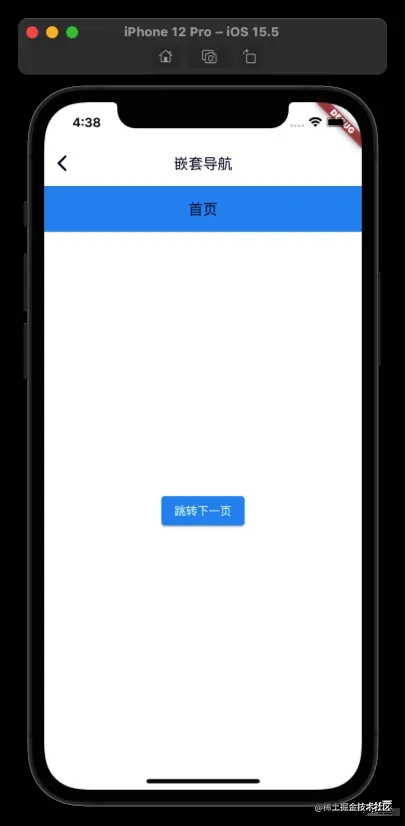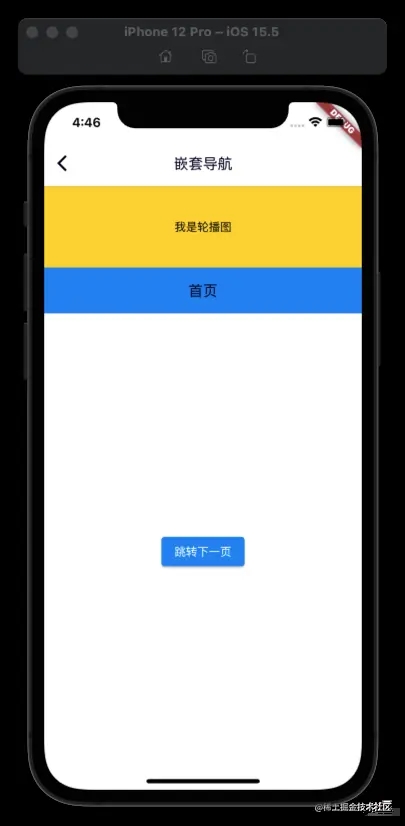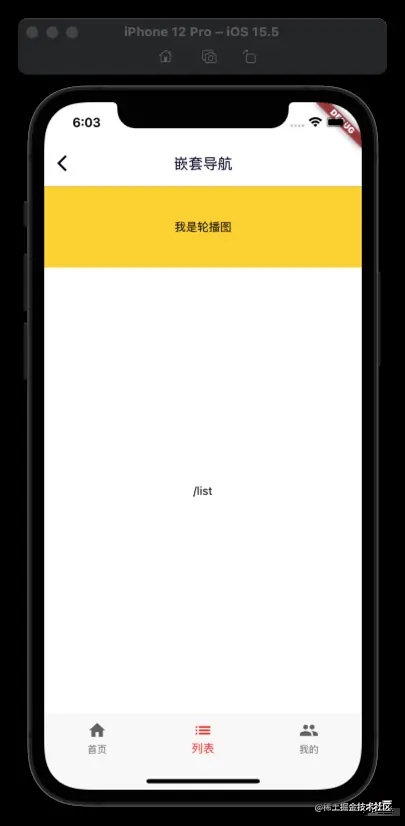1. 嵌套导航-getpageroute
本文主要介绍在getx下快速实现一个嵌套导航
嵌套导航顾名思义,我们导航页面中嵌套一个独立的路由,效果如下

点击跳转

代码如下,也是比较简单
return scaffold(
appbar: appbar(title: const text('嵌套导航'),),
body: navigator(
key: get.nestedkey(1), // create a key by index
initialroute: '/',
ongenerateroute: (settings) {
if (settings.name == '/') {
return getpageroute(
page: () => scaffold(
appbar: appbar(
title: const text("首页"), backgroundcolor: colors.blue
),
body: center(
child: elevatedbutton(
onpressed: () {
get.tonamed('/second', id:1); // navigate by your nested route by index
},
child: const text("跳转下一页"),
),
),
),
);
} else if (settings.name == '/second') {
return getpageroute(
page: () => center(
child: scaffold(
appbar: appbar(
title: const text("第二页"),backgroundcolor: colors.blue
),
body: const center(
child: text("第二页")
),
),
),
);
}
}
),
);
通过navigator这个widget把我们的路由放入新的导航中,通过ongenerateroute来区分页面的路由跳转,key使用的是get.nestedkey(1)来区分具体页面。getpageroute创建路由页面
2. 自定义拓展
我们也可以添加占位图,用于存放一些广告页

column(
children: [
container(
color: colors.amberaccent,
height: 100,
child: const center(child: text('我是轮播图')),
),
expanded(
child: navigator())]
这里使用column进行包裹,expanded撑开下部分。
3. 使用bottomnavigationbar

class nestednavigatepage extends statelesswidget {
const nestednavigatepage({key? key}) : super(key: key);
@override
widget build(buildcontext context) {
final logic = get.find<nestednavigatelogic>();
final state = get.find<nestednavigatelogic>().state;
return scaffold(
appbar: appbar(title: const text('嵌套导航'),),
body: column(
children: [
container(
color: colors.amberaccent,
height: 100,
child: const center(child: text('我是轮播图')),
),
expanded(
child: navigator(
key: get.nestedkey(1), // create a key by index
initialroute: '/home',
ongenerateroute: logic.ongenerateroute,
),
),
],
),
bottomnavigationbar:obx(() => bottomnavigationbar(
items: const [
bottomnavigationbaritem(icon: icon(icons.home),label: '首页'),
bottomnavigationbaritem(icon: icon(icons.list),label: '列表'),
bottomnavigationbaritem(icon: icon(icons.people),label:'我的'),
],
currentindex: state.selectindex.value,
ontap: logic.selecttabbarindex,
selecteditemcolor: colors.red,
)),
);
}
}
state中定义数据
class nestednavigatestate {
var selectindex = 0.obs;
list<string> pages = ['/home','/list','/mine'];
nestednavigatestate() {
///initialize variables
}
}
logic中实现逻辑
import 'package:flutter/material.dart';
import 'package:get/get.dart';
import 'nested_navigate_state.dart';
class nestednavigatelogic extends getxcontroller {
final nestednavigatestate state = nestednavigatestate();
selecttabbarindex( int index){
state.selectindex.value = index;
get.tonamed(state.pages[index],id: 1);
}
route? ongenerateroute(routesettings settings) {
return getpageroute(
settings: settings,
page: () => page(settings.name!),
transition: transition.lefttorightwithfade,
);
}
widget page(string title) {
return center(
child: scaffold(
// appbar: appbar(
// title: text(title), backgroundcolor: colors.blue
// ),
body: center(
child: text(title)
)
));
}
}
点击通过obx自动响应

4.小结
我们通过getpageroute可以进行导航嵌套,方便我们实现一些特定需求。同时我们可以配合bottomnavigationbar实现tabbr效果。 创建平行导航堆栈可能是危险的。
理想的情况是不要使用nestednavigators,或者尽量少用。如果你的项目需要它,请继续,但请记住,在内存中保持多个导航堆栈可能不是一个好主意。
以上就是flutter getpageroute实现嵌套导航学习的详细内容,更多关于flutter getpageroute嵌套导航的资料请关注代码网其它相关文章!






发表评论